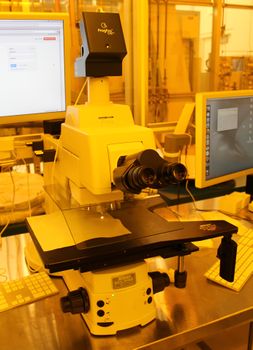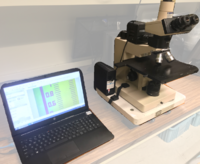Microscopes
|
Procedures & Tools
Most General-Use Microscopes do not require formal training - please see the pages below for specifics.
Microscope Training Guide
This guide explains general usage info & the many advanced features available on most of our microscopes. New users are encouraged to read this, and optionally request in-person training by Demis.
DO NOT TURN MICROSCOPE OBJECTIVES BY HAND for motorized microscopes! Most of our scopes have motorized objective turrets, use the electronic buttons instead.
Image Analysis Software
Many of our microscopes have cameras and software for image capture. If you know the microscope and objective used for acquiring a photo, you can make calibrated measurements on the photos at your own desktop using the following software:
- AmScope Software - free microscope image analysis software
- Amscope Quickstart Usage Guide
- AmScope Calibration File containing calibrations for all NanoFab microscopes: Download Here
- Also available on Nanofiles-SFTP / Manuals / Amscope
- FIJI - scientific image anaylsis software
- The Microscope Measurement Tools plugin has pre-configured calibrations for NanoFab microscopes & SEMs, and allows you to draw length measurements.
- Calibrations in this plugin repository are out of date as of microscope upgrades in 2019.
- There are many other useful plugins, for particle counting, creating animations etc.
- The Microscope Measurement Tools plugin has pre-configured calibrations for NanoFab microscopes & SEMs, and allows you to draw length measurements.
General-Use Microscopes
These microscopes do not require formal training to use. However, if you have never used a motorized objective turret, please see the Microscope Training Guide for safety info.
Microscope #2: Nikon Optiphot 200 (Bay 2)
- Trinocular: Ocular Binoc. + Camera (Simultaneous)
- Objectives: 5x, 10x, 20x, 50x, 100x, 150x
- Filters: Green, ND
- Bright/Dark Field
- Differential Interference Contrast (DIC/Nomarski)
- DIC only available on 100x and 150x mags due to image quality reduction at low mags due to DIC prisms which were removed for low mags.
- Top Reflected Illumination (Episcopic)
- AMScope 14MP Cameras (Model MU1400B) with calibrated software for measurements. Free Software available for calibrated measurements. See above for software & calibration file link.
Microscope #3: Nikon Eclipse L200 (Bay 6)
- Manual for Nikon Eclipse L200D
- Trinocular: Binoc. + Camera (Mutually Exclusive)
- Objectives: 5x, 10x, 20x, 50x, 100x, 150x
- Filters: Green, ND
- Bright/Dark Field
- Differential Interference Contrast (DIC/Nomarski)
- Top Reflected Illumination (Episcopic)
- AMScope 14MP Cameras (Model MU1400B) with calibrated software for measurements. Free Software available for calibrated measurements. See above for software & calibration file link.
Microscope #4: Nikon Eclipse L200D (Bay 6)
- Trinocular: Binoc. + Camera (Mutually Exclusive)
- Objectives: 5x, 10x, 20x, 50x, 100x, 150x
- Filters: Green, ND
- Bright/Dark Field
- Differential Interference Contrast (DIC/Nomarski)
- Top Reflected (Episcopic) & Bottom Transmission (Diascopic) Illumination
- AMScope 14MP Cameras (Model MU1400B) with calibrated software for measurements. Free Software available for calibrated measurements. See above for software & calibration file link.
Microscope #5: Fluorescence Microscope: Olympus MX51 (Bay 6)
- See the wiki page for the Olympus MX51 for full details
- Trinocular: Binoc. + Camera (Simultaneous)
- Native Olympus Stream Software:
- Photo/video capture
- Calibrated measurement (calibrations locked)
- Objectives: 5x, 10x, 20x, 50x, 100x, 150x
- Filters: Green, ND
- Bright/Dark Field
- Differential Interference Contrast (DIC/Nomarski)
- Top (Episcopic) & Bottom (Diascopic) Illumination
- Three Fluorescence Filters (requires training, see main tool page for specs.)
Microscope #1: Olympus BHMJL (Room 1111)
- Trinocular: Ocular Binoc. + Camera (Exclusive)
- LED Illuminator, Variable
- Objectives: 10x, 20x, 50x, 100x
- Bright/Dark Field
- Top Reflected (Episcopic) & Bottom Transmission (Diascopic) Illumination
- AMScope 14MP Cameras (Model MU1400B) with calibrated software for measurements. Free Software available for calibrated measurements. See above for software & calibration file link.
- User Manual: Olympus BHM Microscopes - Instruction Manual (PDF)
Microscopes Requiring Training
The following microscopes require training from the supervisor. Click on the appropriate tool page to see the supervisor info.
Microscope #6: DUV Microscope: Olympus MX61A-DUV (Bay 4)
Please see the main tool page for detailed info on this microscope: Deep UV Optical Microscope (Olympus)
YOU ARE REQUIRED TO GET TRAINED on this tool before you are allowed to use it! Please contact the Tool Owner to get training.
DUV Camera is non-operational and unable to be repaired. Visible camera is still functional. 2022-02
- Motorized Stage + Objective Turret
- Trinocular: Binoc. + Camera (Simultaneous)
- Objectives: 5x, 10x, 20, 50x, 100x, DUV-100x
- Filters: to be added
- Native Olympus MX61 Software control & Camera
- Calibrated measurements (calibrations locked)
- Z (focus) measurement via motorized stage height
- Deep-UV Light source + DUV Camera
- DUV-100x sub-micron imaging/measurement
Microscope #7: Olympus DSX1000 Digital Microscope (Bay 4)
Please see the main tool page for detailed info on this microscope, click the link above.
YOU ARE REQUIRED TO GET TRAINED on this tool before you are allowed to use it! Please contact the Tool Supervisor to get training.
- Motorized Stage + Objective Turret
- Digital Viewing via Computer
- Objectives: High-Res.: 5x, 50x // Long-Distance + Angled Viewing: 10x, 40x
- Filters:
- Bright Field
- Dark Field
- DIC/Nomarski
- Native Olympus Software control & Camera
- Calibrated measurements (calibrations locked)
- Z (focus) measurement via motorized stage height
- Rapidly capture multiple imaging modes
- Offline Analysis Software available for free
- Tilted Imaging capabilities, for deep (> few micron) features.
Olympus LEXT Confocal Microscope (Bay 4)
See the main tool page for complete info: Laser Scanning Confocal M-scope (Olympus LEXT)
YOU ARE REQUIRED TO GET TRAINED on this tool before you are allowed to use it! Please contact the Tool Owner to get training.
- Motorized stage + Objective Turret
- 100mm wafer stage
- Native Olympus OLS2000 Software & Built-In Camera:
- Calibrated measurement (calibrations locked)
- Image stitching capabilities
- 3D Laser-Scanning Confocal Microscopy capability:
- 3D Topographical measurement (optical profilometry)
- Surface roughness estimations (large roughness)
- Thin-Film Film-Thickness Measurements (thicker films)
Filmetrics F40-UV / Olympus BHMJL (Bay 4)
- Very simple, manual microscope.
- Has spectroscopic reflectometer attached for thin-film measurements in small (<100µm) area.
- See the tool page for Training on the Filmetrics Thin-Film Measurement tool.
Procedures & Documentation
- Microscope Training - General procedures and info for using our microscopes

